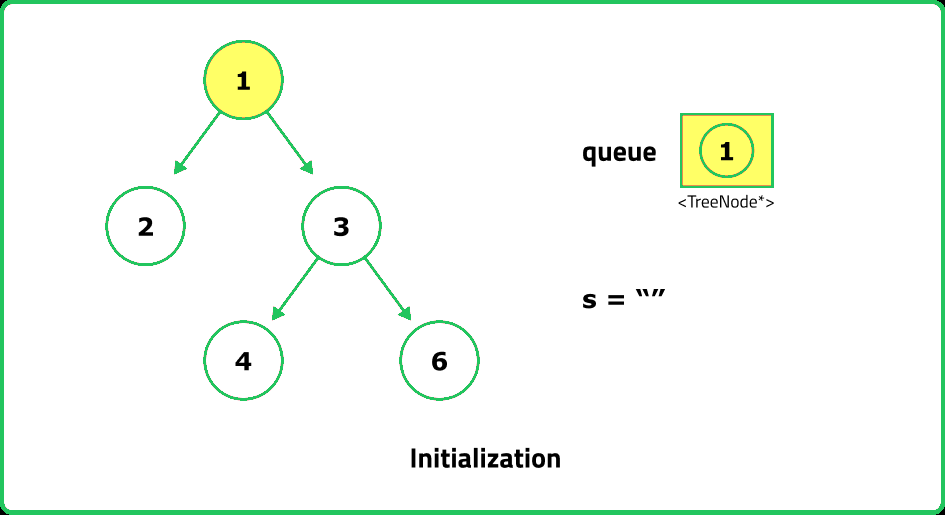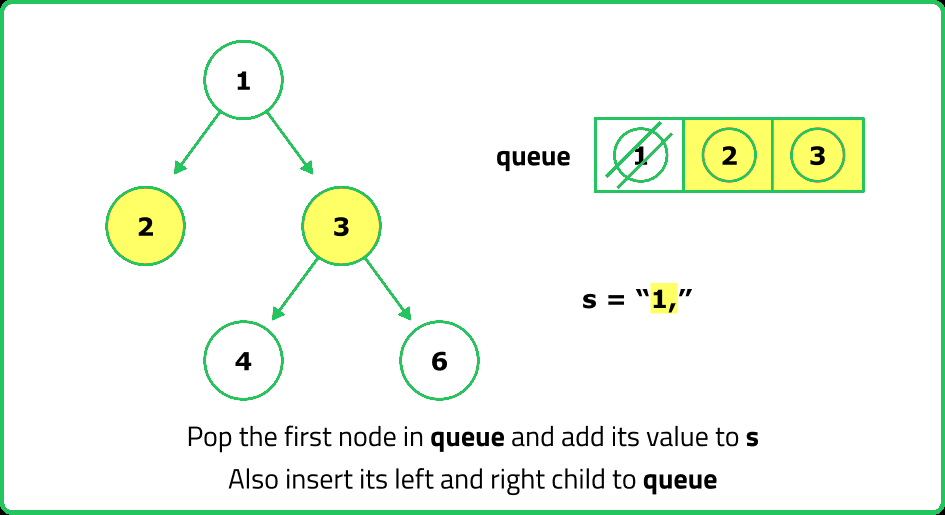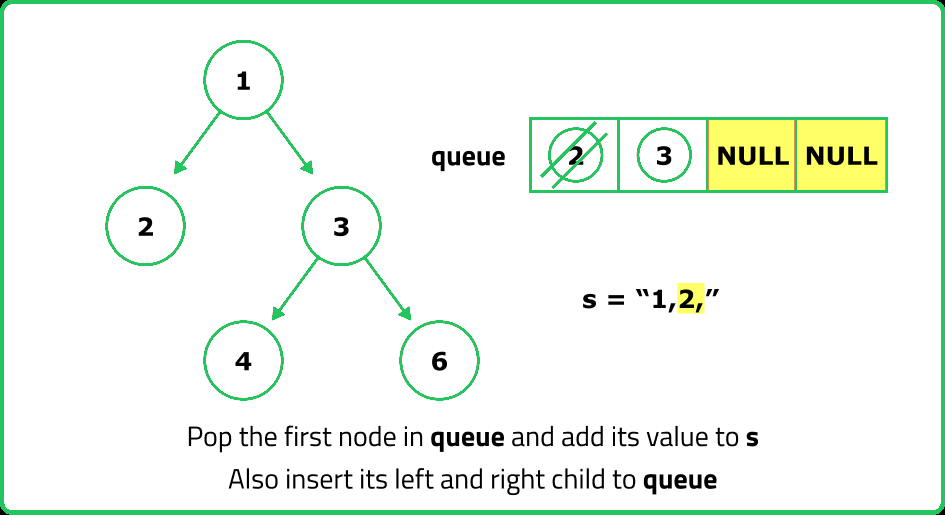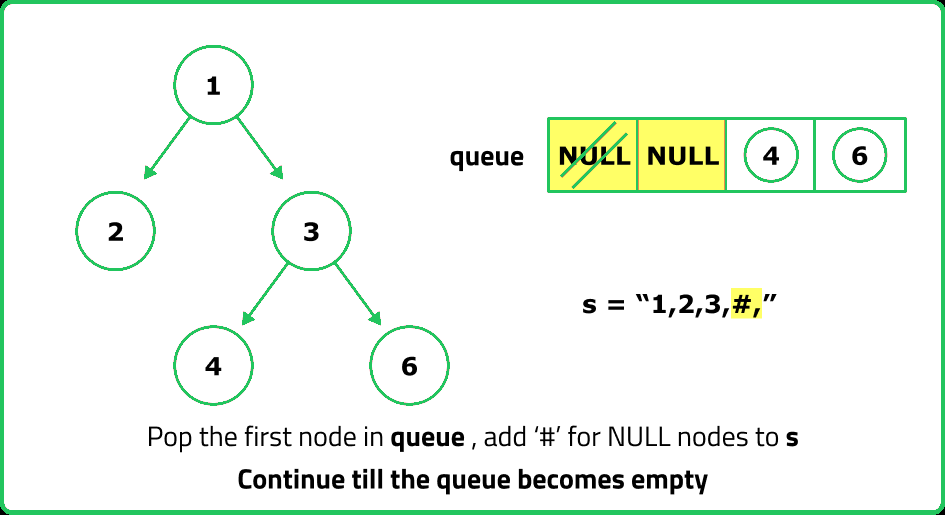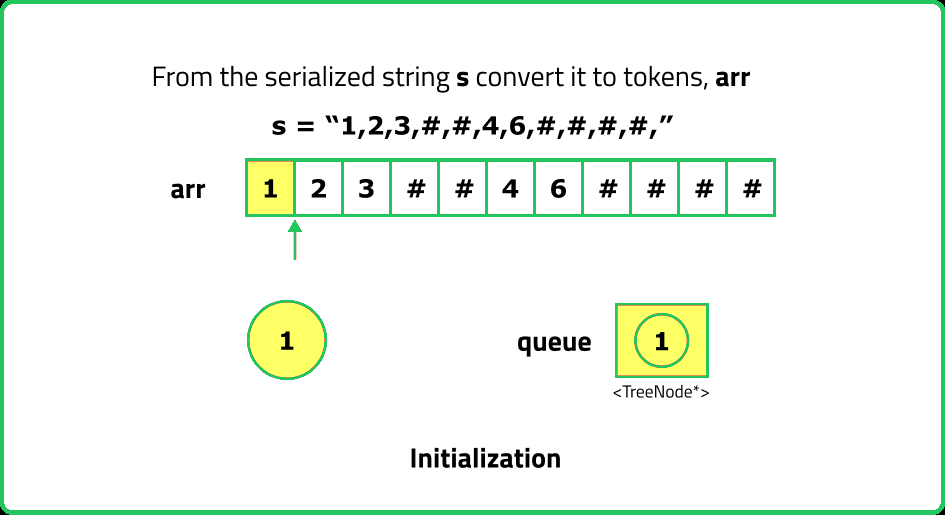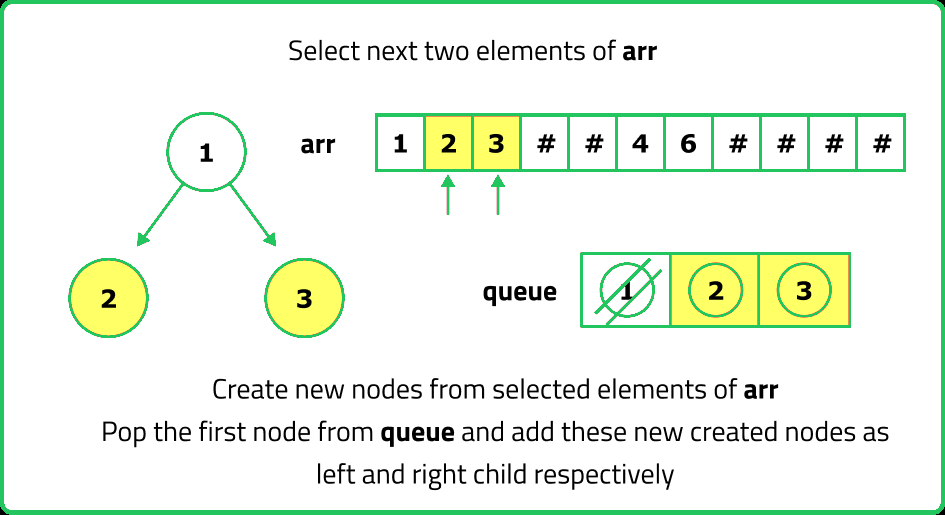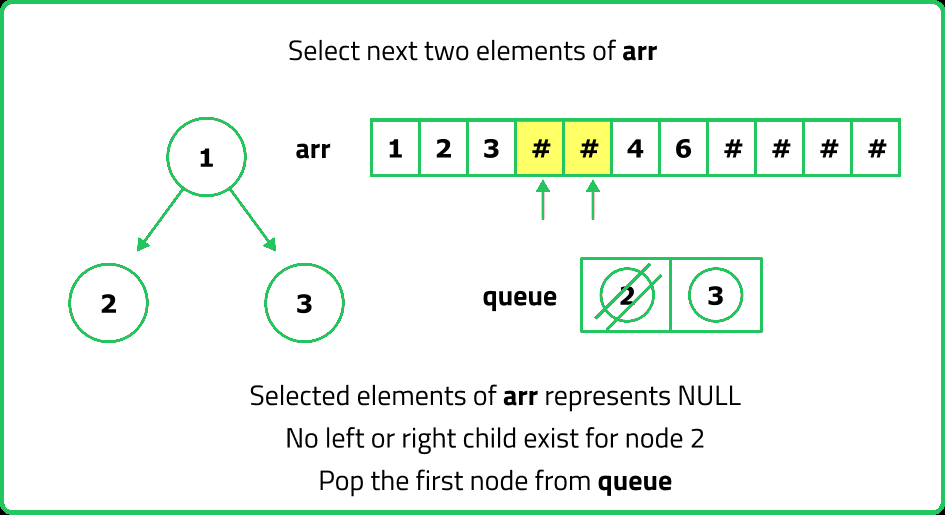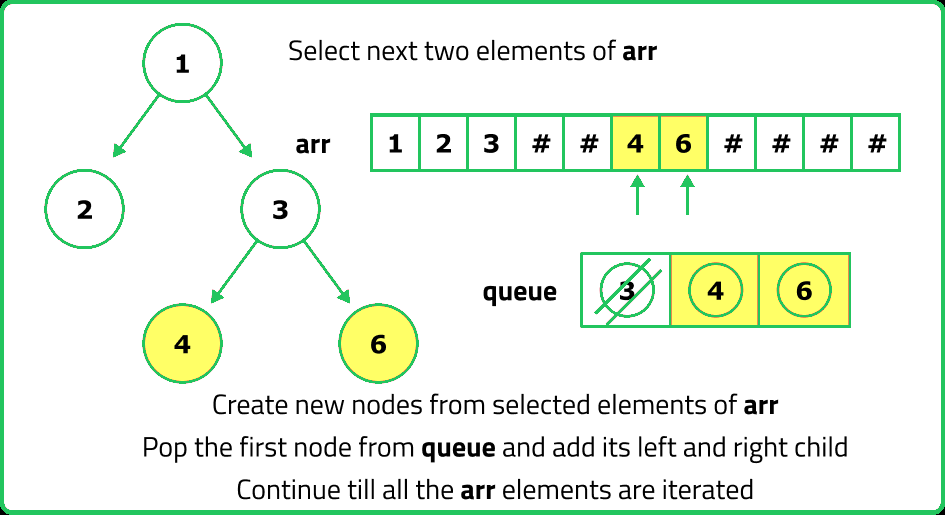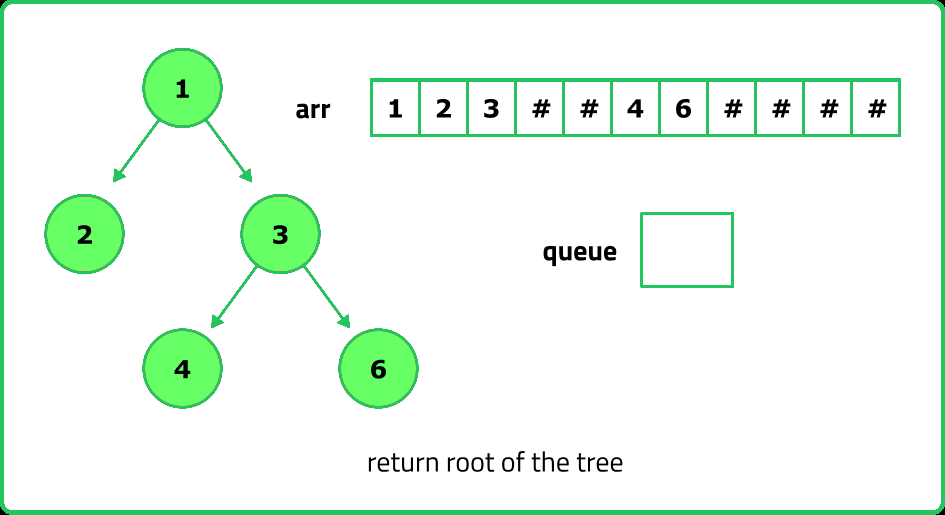123456789101112131415161718192021222324252627282930313233343536373839404142434445464748495051525354555657585960616263646566676869707172737475767778798081828384858687888990919293949596979899100101102103104105106107108109110111112113114115116117118119120121122123124125126127
#include <bits/stdc++.h>
using namespace std;
// Definition for a binary tree node.
struct TreeNode {
int data;
TreeNode *left;
TreeNode *right;
TreeNode(int val) : data(val) , left(nullptr) , right(nullptr) {}
};
class Solution {
public:
// Encodes the tree into a single string
string serialize(TreeNode* root) {
if (root == nullptr) {
return "";
}
// Initialize an empty string
// to store the serialized data
stringstream ss;
// Use a queue for level-order traversal
queue<TreeNode*> q;
// Start with the root node
q.push(root);
// Perform level-order traversal
while (!q.empty()) {
// Get the front node in the queue
TreeNode* curNode = q.front();
q.pop();
// Check if the current node is null and append "#" to the string
if (curNode == nullptr) {
ss << "#,";
} else {
// Append the value of the current node to the string
ss << curNode->data << ",";
// Push the left and right children to the queue for further traversal
q.push(curNode->left);
q.push(curNode->right);
}
}
// Return the serialized string
return ss.str();
}
// Decode the encoded data to a tree
TreeNode* deserialize(string data) {
if (data.empty()) {
return nullptr;
}
// Use a stringstream to tokenize the serialized data
stringstream s(data);
string str;
getline(s, str, ',');
// Read the root value from the serialized data
TreeNode* root = new TreeNode(stoi(str));
// Use a queue for level-order traversal
queue<TreeNode*> q;
// Start with the root node
q.push(root);
// Perform level-order traversal to reconstruct the tree
while (!q.empty()) {
TreeNode* node = q.front();
q.pop();
// Read the value of the left child from the serialized data
getline(s, str, ',');
if (str != "#") {
TreeNode* leftNode = new TreeNode(stoi(str));
node->left = leftNode;
q.push(leftNode);
}
// Read the value of the right child from the serialized data
getline(s, str, ',');
if (str != "#") {
TreeNode* rightNode = new TreeNode(stoi(str));
node->right = rightNode;
q.push(rightNode);
}
}
// Return the reconstructed root of the tree
return root;
}
static void inorder(TreeNode* root) {
if (root == nullptr) {
return;
}
inorder(root->left);
cout << root->data << " ";
inorder(root->right);
}
};
int main() {
TreeNode* root = new TreeNode(1);
root->left = new TreeNode(2);
root->right = new TreeNode(3);
root->right->left = new TreeNode(4);
root->right->right = new TreeNode(5);
Solution solution;
cout << "Original Tree: ";
Solution::inorder(root);
cout << endl;
string serialized = solution.serialize(root);
cout << "Serialized: " << serialized << endl;
TreeNode* deserialized = solution.deserialize(serialized);
cout << "Tree after deserialization: ";
Solution::inorder(deserialized);
cout << endl;
return 0;
}
123456789101112131415161718192021222324252627282930313233343536373839404142434445464748495051525354555657585960616263646566676869707172737475767778798081828384858687888990919293949596979899100101102103104105106107108109110111112113114115116117118119120121122123124125126
import java.util.LinkedList;
import java.util.Queue;
// Definition for a binary tree node.
public class TreeNode {
int data;
TreeNode left;
TreeNode right;
TreeNode(int val) { data = val; left = null, right = null }
}
class Solution {
// Encodes the tree into a single string
public String serialize(TreeNode root) {
if (root == null) {
return "";
}
// Initialize an empty string to store the serialized data
StringBuilder sb = new StringBuilder();
// Use a queue for level-order traversal
Queue<TreeNode> q = new LinkedList<>();
// Start with the root node
q.offer(root);
// Perform level-order traversal
while (!q.isEmpty()) {
TreeNode curNode = q.poll();
// Check if the current node is null and append "#" to the string
if (curNode == null) {
sb.append("#,");
} else {
// Append the value of the current node to the string
sb.append(curNode.data).append(",");
// Push the left and right children to the queue for further traversal
q.offer(curNode.left);
q.offer(curNode.right);
}
}
// Return the serialized string
return sb.toString();
}
// Decode the encoded data to a tree
public TreeNode deserialize(String data) {
if (data.isEmpty()) {
return null;
}
// Use a StringBuilder to tokenize the serialized data
StringBuilder s = new StringBuilder(data);
String str;
int commaIndex = s.indexOf(",");
str = s.substring(0, commaIndex);
s.delete(0, commaIndex + 1);
// Read the root value from the serialized data
TreeNode root = new TreeNode(Integer.parseInt(str));
// Use a queue for level-order traversal
Queue<TreeNode> q = new LinkedList<>();
// Start with the root node
q.offer(root);
// Perform level-order traversal to reconstruct the tree
while (!q.isEmpty()) {
TreeNode node = q.poll();
// Read the value of the left child from the serialized data
commaIndex = s.indexOf(",");
str = s.substring(0, commaIndex);
s.delete(0, commaIndex + 1);
if (!str.equals("#")) {
TreeNode leftNode = new TreeNode(Integer.parseInt(str));
node.left = leftNode;
q.offer(leftNode);
}
// Read the value of the right child from the serialized data
commaIndex = s.indexOf(",");
str = s.substring(0, commaIndex);
s.delete(0, commaIndex + 1);
if (!str.equals("#")) {
TreeNode rightNode = new TreeNode(Integer.parseInt(str));
node.right = rightNode;
q.offer(rightNode);
}
}
// Return the reconstructed root of the tree
return root;
}
public static void inorder(TreeNode root) {
if (root == null) {
return;
}
inorder(root.left);
System.out.print(root.data + " ");
inorder(root.right);
}
public static void main(String[] args) {
TreeNode root = new TreeNode(1);
root.left = new TreeNode(2);
root.right = new TreeNode(3);
root.right.left = new TreeNode(4);
root.right.right = new TreeNode(5);
Solution solution = new Solution();
System.out.print("Original Tree: ");
inorder(root);
System.out.println();
String serialized = solution.serialize(root);
System.out.println("Serialized: " + serialized);
TreeNode deserialized = solution.deserialize(serialized);
System.out.print("Tree after deserialization: ");
inorder(deserialized);
System.out.println();
}
}
123456789101112131415161718192021222324252627282930313233343536373839404142434445464748495051525354555657585960616263646566676869707172737475767778798081828384858687888990919293949596979899100101102103104105106107108109110111
from collections import deque
# Definition for a binary tree node.
class TreeNode(object):
def __init__(self, val=0, left=None, right=None):
self.data = val
self.left = left
self.right = right
class Solution:
def serialize(self, root):
"""
Encodes the tree into a single string.
:type root: TreeNode
:rtype: str
"""
if not root:
return ""
# Initialize an empty string to store the serialized data
result = []
# Use a queue for level-order traversal
q = deque([root])
# Perform level-order traversal
while q:
node = q.popleft()
if node is None:
result.append("#")
else:
result.append(str(node.data))
# Push the left and right children to the queue for further traversal
q.append(node.left)
q.append(node.right)
# Return the serialized string
return ",".join(result)
def deserialize(self, data):
"""
Decodes the encoded data to a tree.
:type data: str
:rtype: TreeNode
"""
if not data:
return None
# Use a deque to tokenize the serialized data
data = deque(data.split(","))
# Read the root value from the serialized data
root = TreeNode(int(data.popleft()))
# Use a queue for level-order traversal
q = deque([root])
# Perform level-order traversal to reconstruct the tree
while q:
node = q.popleft()
# Read the value of the left child from the serialized data
left_val = data.popleft()
if left_val != "#":
left_node = TreeNode(int(left_val))
node.left = left_node
q.append(left_node)
# Read the value of the right child from the serialized data
right_val = data.popleft()
if right_val != "#":
right_node = TreeNode(int(right_val))
node.right = right_node
q.append(right_node)
# Return the reconstructed root of the tree
return root
# Your Codec object will be instantiated and called as such:
# ser = Codec()
# deser = Codec()
# tree = ser.serialize(root)
# ans = deser.deserialize(tree)
# return ans
# Testing the Solution
if __name__ == "__main__":
# Create the binary tree
root = TreeNode(1)
root.left = TreeNode(2)
root.right = TreeNode(3)
root.right.left = TreeNode(4)
root.right.right = TreeNode(5)
solution = Solution()
print("Original Tree: ", end="")
def inorder(root):
if root is None:
return
inorder(root.left)
print(root.data, end=" ")
inorder(root.right)
inorder(root)
print()
serialized = solution.serialize(root)
print("Serialized:", serialized)
deserialized = solution.deserialize(serialized)
print("Tree after deserialization: ", end="")
inorder(deserialized)
print()
123456789101112131415161718192021222324252627282930313233343536373839404142434445464748495051525354555657585960616263646566676869707172737475767778798081828384858687888990919293949596979899100101102103104105106107108
// Definition for a binary tree node.
class TreeNode {
constructor(val = 0, left = null, right = null){
this.data = val;
this.left = left;
this.right = right;
}
}
class Solution {
// Encodes the tree into a single string
serialize(root) {
if (root === null) {
return "";
}
// Initialize an empty string to store the serialized data
let result = [];
// Use a queue for level-order traversal
let queue = [root];
// Perform level-order traversal
while (queue.length) {
let node = queue.shift();
if (node === null) {
result.push("#");
} else {
result.push(node.data);
// Push the left and right children to the queue for further traversal
queue.push(node.left);
queue.push(node.right);
}
}
// Return the serialized string
return result.join(",");
}
// Decode the encoded data to a tree
deserialize(data) {
if (data === "") {
return null;
}
// Use a string tokenizer to extract node values
let nodes = data.split(",");
// Read the root value from the serialized data
let root = new TreeNode(parseInt(nodes.shift()));
// Use a queue for level-order traversal
let queue = [root];
// Perform level-order traversal to reconstruct the tree
while (queue.length) {
let node = queue.shift();
// Read the value of the left child from the serialized data
let leftVal = nodes.shift();
if (leftVal !== "#") {
let leftNode = new TreeNode(parseInt(leftVal));
node.left = leftNode;
queue.push(leftNode);
}
// Read the value of the right child from the serialized data
let rightVal = nodes.shift();
if (rightVal !== "#") {
let rightNode = new TreeNode(parseInt(rightVal));
node.right = rightNode;
queue.push(rightNode);
}
}
// Return the reconstructed root of the tree
return root;
}
}
// Testing the Solution
function inorder(root) {
if (root === null) {
return;
}
inorder(root.left);
console.log(root.data + " ");
inorder(root.right);
}
// Create the binary tree
let root = new TreeNode(1);
root.left = new TreeNode(2);
root.right = new TreeNode(3);
root.right.left = new TreeNode(4);
root.right.right = new TreeNode(5);
let solution = new Solution();
console.log("Original Tree:");
inorder(root);
let serialized = solution.serialize(root);
console.log("Serialized:", serialized);
let deserialized = solution.deserialize(serialized);
console.log("Tree after deserialization:");
inorder(deserialized);
